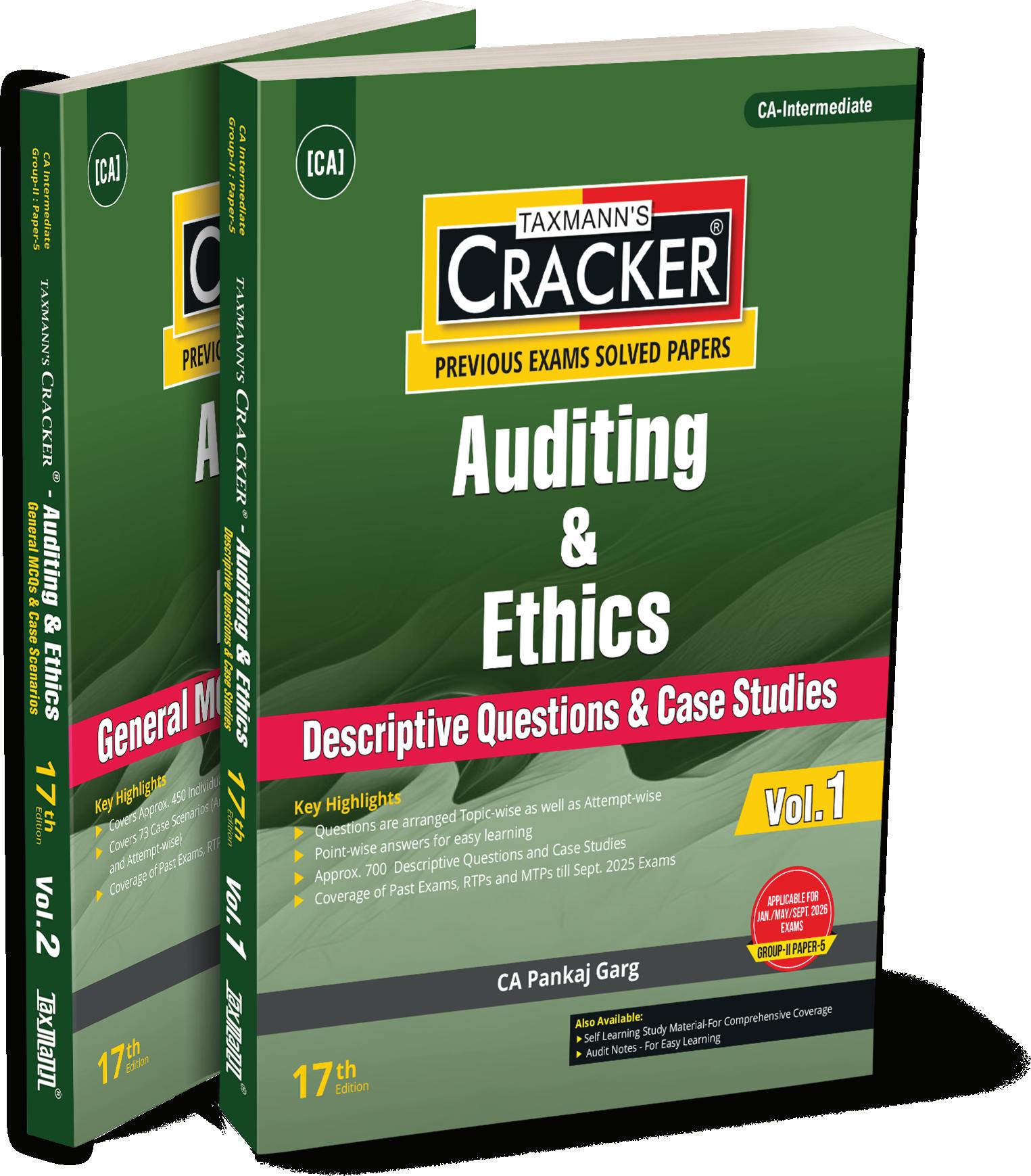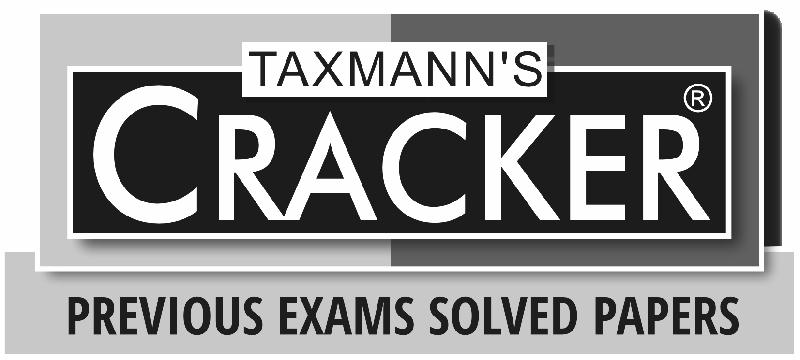Audit of Items of Financial Statements
5.1 – Assertions
Q.1 A company is engaged in manufacturing of fabrics from yarn purchased from different suppliers. Occasionally, it also manufactures fabrics tailor made in accordance with requirements of certain mills from yarn received from these mills. The company raises bill of its labour charges only on mills for converting yarn into fabrics. The auditor of company tries to ensure that stocks of the company as at year end do not include stocks pertaining to these mills. Which assertion auditor tries to verify in above situation? How he can ensure that?
Ans.: Identification of Assertions examined :
Auditor is trying to verify assertion relating to “Rights and Obligations”. He is verifying that the company owns or controls the inventory recorded in the financial statements. Any inventory held by company on behalf of another entity has not been recognized as part of inventory.
This can be achieved by verifying stock records pertaining to goods received from mills and sent back to mills after carrying out necessary operations. Besides, agreements with such mills may also be verified.
Q.2 Companies prepare their financial statements in accordance with the framework of Generally Accepted Accounting Principles (Indian GAAP), also commonly referred to as Accounting Standards (AS). In preparing financial statements, Company’s management makes implicit or explicit claims (i.e. assertions) regarding assets, liabilities, equity, income, expenses and disclosures in accordance with the applicable accounting standards. Explain with example stating the relevant assertions involved in this regard. Also explain financial statement audit. [RTP -May 20]
Ans.: Assertions involved in preparation of financial statements:
• Companies prepare their financial statements in accordance with the framework of generally accepted accounting principles, also commonly referred to as accounting standards (AS).
• In preparing F.S., company’s management makes implicit or explicit claims ( i.e. assertions) regarding:
(1) Completeness;
(2) Cut-off;
(3) Existence/ Occurrence;
(4) Valuation/ Measurement;
(5) Rights and Obligations; and
(6) Presentation and Disclosure of assets, liabilities, equity, income, expenses and disclosures in accordance with applicable ASs.
Example: If balance sheet of an entity shows machinery with carrying amount of ₹ 25 lakh, the auditor shall assume that the management has claimed/ asserted that:
(1) Machinery recognized in the balance sheet exists as at the period-end (existence assertion);
(2) Entity owns and controls such machinery (Rights and obligations assertion);
(3) Machinery has been valued accurately in accordance with the valuation principles (Valuation assertion);
(4) All machineries owned and controlled by the entity are included within the carrying amount of ₹ 25 lakh (Completeness assertion).
Financial Statement Audit:
A financial statement audit comprises the examination of entity’s financial statements and accompanying disclosures by an independent auditor. Result of this examination is a report by the auditor, attesting to truth & fairness of presentation of financial statements & related disclosures.
Q.3 What does the valuation assertion mean in respect of Assets, liabilities and equity balances? Explain with the help of example in respect of Inventory.
Ans.: Meaning of Valuation Assertion:
[RTP -May 20]
Valuation assertion in respect of Assets, liabilities and equity balances means that Assets, liabilities, and equity interests are included in the financial statements at appropriate amounts and any resulting valuation or allocation adjustments are appropriately recorded.
Example of Valuation assertion w.r.t. Inventory :
As per AS 2 “Valuation of Inventories” inventory is to be recognized at the lower of cost and net realizable value. Any costs that could not be reasonably allocated to the cost of production (e.g. general and administrative costs) and any abnormal wastage have been excluded from the cost of inventory. An acceptable valuation basis (e.g. FIFO, Weighted average etc.) has been used to value inventory as at the period-end.
Q.4 Name the assertion that the auditor will check by performing the following audit procedures.
(a) Employees benefit expense in respect of all personnel have been fully accounted for.
(b) Discounts on sales has been properly adjusted/ accounted for.
(c) Employee benefit expense recorded during the period relates to the current accounting period only. [MTP-March 23]
Ans.: Assertion checked by auditor:
(a) Completeness
(b) Measurement
(c) Cut Off
Q.5 A junior accountant of a limited company has not separated transactions of one period from those in the ensuing period. As an Auditor, state the correct procedure to be followed and the areas in which it can be applied. [RTP-Nov. 23]
Ans.: Cut-off Arrangement:
Accounting is a continuous process because the business never comes to halt. Hence, it becomes necessary that transactions of one period would be separated from those in the ensuing period so that the results of the working of each period can be correctly ascertained. The arrangement that is made for this purpose is technically known as “cut-off arrangement”.
It essentially forms part of the internal control system of the organisation.
Audit of Items of Financial Statements
Accounts, other than sales, purchase and inventory are not usually affected by continuity of the business and therefore, this arrangement is generally applied to sales, purchase and inventory.
Auditor satisfies by examination and test-checks that cut-off procedures are adequately followed and ensure that:
(i) Goods purchased, property in which has already been passed on to client, have in fact been included in inventories and that the liability has been provided for in case credit purchase.
(ii) Goods sold have been excluded from the inventories and credit has been taken for the sales. If the value of sales is to be received, the concerned party has been debited.
Auditor may examine a sample of documents, evidencing movement of inventory into and out of stores, including documents pertaining to period shortly before and after the cut -off date and check whether inventories represented by those documents were included or excluded as appropriate during inventory taking for perfect and correct presentation in the F.S.
Q.6 Identify & explain the assertions that auditor will check by performing following audit procedures:
(i) Employee benefit expenses do not include the cost of any unauthorised personnel.
(ii) All the items of inventory pertaining to the relevant year shall be included regardless of the location.
(iii) Sales are recorded correctly in the books based on the invoices. Discounts have been properly adjusted or accounted for.
(iv) The entity owns or controls the inventory recorded in the financial statements. i.e. the purchase invoices have been made in the name of the client.
(v) Inventory has been recognised at the lower of cost and net realizable value in accordance with AS 2 - Inventories. [Jan. 25 (5 Marks)]
Ans.: Assertions involved in preparation of financial statements:
(i) For Employee benefit expenses do not include the cost of any unauthorised personnel: The auditor will check the occurrence assertion for the same to ensure that transactions recognised in the financial statements have occurred and relate to the entity.
(ii) All the items of inventory pertaining to the relevant year shall be included regardless of the location: The auditor will check the cut-off assertion to ensure that all assets and liabilities are reported in the appropriate period.
(iii) Sales are recorded correctly in the books based on the invoices. Discounts have been properly adjusted or accounted for : The auditor will check measurement assertion to ensure transactions have been recorded accurately at their appropriate amounts in the financial statements. There have been no errors while preparing documents or in posting transactions to ledger. The figures and explanations are not misstated.
(iv) The entity owns or controls the inventory recorded in the financial statements. i.e., the purchase invoices have been made in the name of the client : The auditor will check rights & obligations assertion to ensure that the entity has the right to assets (i.e. whether the entity has ownership and legal title to assets), and the liabilities recognised in the financial statements represent all the entity’s obligations to repayment as at a given date.
(v) Inventory has been recognised at the lower of cost and net realizable value in accordance with AS 2 - Inventories: The auditor will check valuation assertion to ensure assets, liabilities and equity balances have been valued appropriately i.e. the amounts at which they are recorded are appropriate. There has been no overstatement or understatement
Q.7 Identify and explain the assertions that the auditor will check by performing the following audit procedures:
(i) Inventory recognised in the balance sheet actually existed as at the period end.
(ii) All goods dispatched prior to the period/ year -end have been invoiced and included in debtors on a test check basis.
(iii) Examine client correspondence, sales and receivables records, purchase documents.
(iv) Verifying that the entity has charged depreciation on all items of PPE unless any item of PPE is non-depreciable like freehold land. [M TP-April 25]
Ans.: Assertions:
(i) The auditor will check the Existence Assertion to ensure Assets, liabilities and equity balances exist as at the period end.
(ii) The auditor will check Completeness Assertion to ensure all Trade receivable balances that were supposed to be recorded have been recognized in the financial statements.
(iv) The auditor will check Rights & Obligations assertion to ensure that the entity has valid legal ownership rights over the inventories claimed to be held by the entity and recorded in the financial statements.
(iii) The auditor will check Valuation assertion to ensure PPE have been valued appropriately and as per generally accepted accounting policies and practices.
Q.8 Identify and explain the assertions that the auditor will check by performing the following audit procedures:
(i) Any inventory held by the entity on behalf of another entity has not been recognised as part of inventory of the entity.
(ii) Employee benefit expense has been incurred during the period in respect of the personnel employed by the entity.
(iii) Sales shall include the despatch of goods made at the year -end as they belong to the relevant period.
(iv) Any inventory held by a third party on behalf of the entity has been included as part of the inventory balance. [MTP-Aug. 25]
Ans.: Assertions checked by the Auditor:
(i) The auditor will check Rights & Obligations assertion to ensure that the entity has the right to assets i.e. (whether the entity has ownership and legal title to assets) and the liabilities recognised in the financial statements represent all the entity’s obligations to repayment as at a given date.
(ii) The auditor will check Occurrence assertion to ensure that the transactions recognized in the financial statements have occurred and relate to the entity.
(iii) The auditor will check Cut-off assertion to ensure that all income and expenses are reported in the-correct accounting period. Cut-off is a separate assertion because the substantive procedures to verify it are typically different from those applied to the other components of completeness.
(iv) The auditor will verify Completeness assertion to ensure that all assets, liabilities and equity balances that were supposed to be recorded have been recognized in the financial statements.
Q.9 Identify and explain the assertions that the auditor will check by performing the following audit procedures:
Chapter 5
Audit of Items of Financial Statements
(i) Employee benefit expenses recognised during the period relates to the current accounting period only.
(ii) Employee benefit expenses in respect of all personnel have been fully accounted for.
(iii) Recorded sales represent goods which were ordered by valid customers and were despatched and invoiced in the period. [RTP-Sep. 25]
Ans.: Assertions checked by the Auditor:
(i) The auditor will check the cut-off assertion to ensure that whether all income and expenses are reported in the-correct accounting period. Cut-off is a separate assertion because the substantive procedures to verify it are typically different from those applied to the other components of completeness.
(ii) The auditor will check the completeness assertion for the same to ensure that all transactions that were supposed to be recorded have been recognised in the financial statements. Transactions have not been omitted.
(iii) The auditor will check the occurrence assertion for the same to ensure that transactions recognised in the financial statements have occurred and relate to the entity.
5.2 – Audit of Share Capital
Q.10 The securities premium account may only be applied by the company towards the issue of unissued shares of the company to the members of the company as fully paid bonus shares, Comment. [May 19 (3 Marks)] Or
WEQ Ltd. has issued shares for cash at a premium. In accordance with section 52 of the Companies Act, 2013, the company is required to transfer the premium received from the issuance of shares to the securities premium account. What are the specific applications allowed for the funds in the securities premium account, as per the provisions of the Companies Act, 2013? [MTP -March 25]
Ans.:
Issue of Shares at Premium:
Where a company has issued shares at a premium, whether for cash or otherwise, aggregate amount of the premium received on those shares shall be transferred to securities premium account.
As per Sec. 52 of Companies Act, 2013 the securities premium account may be applied by the company for the following purposes:
(a) issue of unissued shares of the company to the members of the company as fully paid bonus shares;
(b) writing off the preliminary expenses of the company;
(c) writing off the expenses of, or the commission paid or discount allowed on, any issue of shares or debentures of the company;
(d) providing for the premium payable on the redemption of any redeemable preference shares or of any debentures of the company; or
(e) for the purchase of its own shares or other securities u/s 68.
Auditor needs to verify whether the premium received on shares, if any, has been transferred to a “securities premium account” and whether the application of any amount out of the said “securities premium account” is only for the purposes mentioned above.
Q.11 What audit points are to be borne in mind in case of issue of “Sweat Equity shares” by a limited company? [MTP-Oct.19]
Ans.: Verification of Sweat Equity Shares:
Auditor is required to verify that the Sweat Equity Shares issued by the company are of a class of shares already issued and following conditions of Sec. 54 of Companies Act, 2013 are fulfilled:
(a) the issue is authorised by a special resolution passed by the company;
(b) the resolution specifies the number of shares, the current market price, consideration, if any, and the class or classes of directors or employees to whom such equity shares are to be issued; and
(c) where equity shares of the company are listed on a recognised stock exchange, sweat equity shares are issued in accordance with regulations made by SEBI in this behalf and if they are not so listed, the sweat equity shares are issued in accordance with such rules as may be prescribed.
Q.12 BNP Ltd. has reduced its Share Capital to a greater extent in the year for which you are conducting the audit. State how will you proceed for verifying the reduction of Capital. [MTP-Oct. 20]
Ans.: Reduction of Share Capital :
The duties of the auditor while verifying reduction of capital will be as follow:
(1) Verifying that the special resolution has been passed for reduction of capital in the meeting of the shareholder.
(2) Check that the Articles of Association authorizes the reduction of capital.
(3) Examine the order of the Tribunal confirming the reduction and ensure that a copy of the order and the minutes have been registered and filed with the ROC.
(4) Inspecting the ROC Certificate as regards reduction of capital.
(5) Vouching the journal entries recorded to reduce the capital and to write down the assets by reference to the resolution of shareholders and other documentary evidence.
(6) Ensure that the requirements of Schedule III w.r.t. reduced capital have been complied with.
(7) Confirming that the revaluation of assets has been properly disclosed in the Balance Sheet.
(8) Verifying the adjustment made in the members’ accounts in the Register of Members and confirming that either the paid-up amount shown on the old share certificates have been altered or new certificates have been issued in lieu of the old, and the old ones have been cancelled.
(9) Confirming that the words “and reduced”, if required by the order of the Tribunal, have been added to the name of the company in the Balance Sheet.
(10) Verifying that the MOA of the company has been suitably altered.
Q.13 While conducting audit of Air Space Ltd., the auditor observes that it has issued shares at discount to its creditors when its debt is converted into shares in pursuance of debt restructuring scheme in accordance with any guidelines specified by the Reserve Bank of India. Discuss explaining clearly the provisions relating to discount on issue of shares and its verification by the auditor.
[MTP-March 22] Or
Management of D Ltd. has issued shares at a discount to its creditors. Explain the provisions of the Companies Act, 2013 when shares are issued at a discount to creditors? As an auditor what will be your concern of checking in such a case? [May 23 (4 Marks)]
Audit of Items of Financial Statements
Ans.: Shares issued at a discount:
As per Sec. 53, a company shall not issue shares at a discount, except in the case of an issue of sweat equity shares given u/s 54 of the Companies Act, 2013.
Any share issued by a company at a discounted price shall be void.
However, a company may issue shares at a discount to its creditors when its debt is converted into shares in pursuance of any statutory resolution plan or debt restructuring scheme in accordance with any guidelines or directions or regulations specified by the RBI under the RBI Act, 1934 or the Banking Regulation Act, 1949.
Where any company fails to comply with the provisions of this section, such company and every officer who is in default shall be liable to a penalty which may extend to an amount equal to the amount raised through the issue of shares at a discount or ₹ 5 lakh, whichever is less, and the company shall also be liable to refund all monies received with interest at the rate of 12% p.a. from the date of issue of such shares to the persons to whom such shares have been issued.
Verification aspects:
(i) Auditor needs to check movement in share capital during the year & wherever there is any issue.
(ii) Auditor should verify that the Company has not issued any of its shares at a discount by reading minutes of meeting of its directors and shareholders authorizing issue of share capital and the issue price.
(iii) Further, auditor should also verify that in case a company has issued shares at a discount to its creditors when its debt is converted into shares in pursuance of any statutory resolution plan or debt restructuring scheme in accordance with any guidelines or directions or regulations specified by the RBI under the RBI Act, 1934 or the Banking Regulation Act, 1949.
Q.14 S & Co., Chartered Accountants, are appointed as the auditors of ABC Ltd. CA S, the engagement partner, has come across the following while verifying equity share capital of the company:
(i) He noticed that some of the equity shares are held by promoters.
(ii) Some shares are issued as sweat equity shares to the employees.
What is the meaning of sweat equity shares?
What are the disclosure requirements of such promoter's shareholding? [Nov. 22 (4 Marks)]
Ans.: Meaning of Sweat Equity Shares:
“Sweat Equity Shares” means equity shares issued by the company to employees or directors at a discount or for consideration other than cash for providing know-how or making available right in the nature of intellectual property rights or value additions, by whatever name called.
Disclosure requirements of promoter’s shareholding:
Schedule III (Division I) of Companies Act, 2013 requires that a company shall disclose Shareholding of Promoters as below:
held by promoters at the end of the year
** Details shall be given separately for each class of shares.
*** % change shall be computed with respect to the number at the beginning of the year or if issued during the year for the first time then with respect to the date of issue.
5.3 – Audit of Reserves and Surplus (Other Equity)
Q.15 While auditing the accounts of ABC Ltd., a member of audit team is not clear about classification of Reserves and Surplus.
You being the senior member of audit team guide the member of the audit team about such classification as per general instructions for preparation of balance sheet as per Schedule III.
[MTP-April 22]
Ans.: Classification of Reserves and Surplus:
Reserves and Surplus shall be classified as:
(a) Capital Reserves;
(b) Capital Redemption Reserve;
(c) Securities Premium;
(d) Debenture Redemption Reserve;
(e) Revaluation Reserve;
(f) Share Options Outstanding Account;
(g) Other Reserves – (specify the nature and purpose of each reserve and the amount in respect thereof);
(h) Surplus i.e. balance in Statement of Profit & Loss disclosing allocations and appropriations such as dividend, bonus shares and transfer to/from reserves etc.
(Additions and deductions since last balance sheet to be shown under each of the specified heads)
A reserve specifically represented by earmarked investments shall be termed as a ‘fund’.
Debit balance of statement of profit and loss shall be shown as a negative figure under the head ‘Surplus’. Similarly, balance of ‘Reserves & Surplus’, after adjusting negative balance of surplus, if any, shall be shown under the head ‘Reserves & Surplus’ even if resulting figure is in the negative.
Q.16 Reserves are a vital source of financing by internal means. Explain and also discuss the meaning of reserves along with revenue reserve and capital reserve. [MTP-Sep. 22]
Ans.: Reserves are a vital source of financing:
Reserves are the amounts appropriated out of profits that are not intended to meet any liability, contingency, commitment or diminution in the value of assets known to exist as at the date of the Balance Sheet.
Reserves are a vital source of financing by internal means. They are held for the purpose of distribution of dividend or financing the expansion of the company or strengthening the company financially. The company utilizes the reserves according to the nature and type of such reserve.
The reserves can be segregated as revenue or capital reserves.
(1) Revenue reserves represent profits that are available for distribution to shareholders or below purposes such as:
to supplement divisible profits in lean years,
to finance an extension of business,
to augment the working capital of the business, or
to generally strengthen the company’s financial position.
Audit of Items of Financial Statements
(2) Capital Reserve represents a reserve which does not include any amount regarded as free for distribution. They can be utilized only for certain limited purposes. Example of such reserves are securities premium, capital redemption reserve.
If a company appropriates revenue profit for being credited to the asset replacement reserve with the objective that these are to be used for a capital purpose, such a reserve shall also be in the nature of a capital reserve.
5.4 – Audit of Borrowings
Q.17 On going through the financial statements of PQR Ltd., its auditors Kamal Gagan and Associates observed that company has taken Loans from banks and financial institutions. Further, the audit team discusses the following about Liabilities:
“Liabilities are the financial obligations of an enterprise other than owners’ funds. Liabilities include loans/borrowings, trade payables and other current liabilities, deferred payment credits and provisions.
Verification of liabilities is as important as that of assets, for, if any liability is omitted (or understated) or over stated, the Balance Sheet would not show a true and fair view of the state of affairs of the company.”
Advise stating clearly the audit procedures generally required to be undertaken for verification of Borrowings. [MTP-March 18, Oct. 18]
Ans.: Verification of Borrowings from Banks:
Borrowing from banks may be either in the form of overdraft limits or term loans. In each case, the borrowings should be verified as follows:
(i) Reconcile the balances in the overdrafts or loan accounts with that shown in the pass book(s) and confirm the last-mentioned balance by obtaining a certificate from the bank showing the balance in the accounts as at the end of the year.
(ii) Obtain independent balance confirmation from the bank showing balances, particulars of securities deposited with the bank as security for the loans or of the charge created on an asset and confirm that the same has been correctly disclosed and duly registered with RoC and recorded in the Register of charges.
(iii) Verify the authority under which the loan or draft has been raised. In the case of a company, only the BoD is authorised to raise a loan or borrow from a bank.
(iv) Confirm, in case of a company, that restraint contained in Sec. 180 of the Companies Act, 2013 as regards the maximum amount of loan that the company can raise has not been contravened.
(v) Ascertain the purpose for which loan has been raised and the manner in which it has been utilised and that this has not prejudicially affected the entity.
Q.18 How is "Short Term Borrowings" disclosed in the Financial Statements as required under Part I of Schedule III to the Companies Act, 2013? [No v. 23 (4 Marks)]
Ans: Disclosure w.r.t. Short Term Borrowings as per Part I of Schedule III:
(i) Short-term borrowings shall be classified as:
(a) Loans repayable on demand; (A) from banks. (B) from other parties.
(b) Loans and advances from related parties;
(c) Deposits;
(d) Other loans and advances (specify nature).
(ii) Borrowings shall further be sub-classified as secured and unsecured. Nature of security shall be specified separately in each case.
(iii) Where loans have been guaranteed by directors or others, the aggregate amount of such loans under each head shall be disclosed.
(iv) Period and amount of default as on balance sheet date in repayment of loans and interest, shall be specified separately in each case.
(v) Current maturities of long-term borrowings shall be disclosed separately.
Q.19 Droma Shoes Private Limited was established in year 202 5-26 for manufacturing of footwear. As funds were needed to carry on its business activities - including for purchase of different raw materials, incurring of regular expenses like power and fuel and payment of wages etc., it had got sanctioned a credit facility amounting to ₹ 2 crores repayable on demand from a bank against primary security of its current assets and collateral security of residential house of one of its directors. Duly signed guarantee documents by directors in favour of bank also form part of bank’s loan documentation. Account statement of above facility downloaded from bank’s website shows debit balance of ₹ 1.85 crores as on 31st March, 202 6. The operations in above credit facility are satisfactory. In this regard:
(i) Identify nomenclature of such credit facility given by banks. How would above amount of ₹ 1.85 crores be reflected and classified in financial statements of company as on 31.3.2 6?
(ii) Also state specific disclosure requirements of Schedule III of Companies Act, 2013 in relation to above. [RTP - May 24]
Ans: Cash Credit/Overdraft Facilities:
(i) The type of credit facilities referred to in above situation given by banks to meet working capital requirements of business which are repayable on demand are known as “cash credit facilities/overdraft” facilities. The amount of ₹ 1.85 crores outstanding as on 31st March, 202 6 reflects borrowings of the company and it would be classified as “short -term borrowings” as loans repayable on demand from banks under current liabilities in balance sheet of the company. Borrowings shall further be subclassified as secured.
(ii) Specific disclosure requirements of short-term borrowings under Schedule III to Companies Act, 2013 in given situation are as under:
Nature of security i.e. primary security of current assets and collateral security of residential house belonging to a director shall be specified.
As loans have been guaranteed by directors, the aggregate amount of such loans shall be disclosed.
To be disclosed as Additional Regulatory Information
Since the Company has borrowings from bank on the basis of security of current assets, it shall also disclose the following:
(a) whether quarterly returns or statements of current assets filed by the Company with banks or financial institutions are in agreement with the books of accounts.
(b) if not, summary of reconciliation and reasons of material discrepancies, if any to be adequately disclosed.










